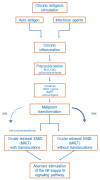The Biology of Ocular Adnexal Marginal Zone Lymphomas
- PMID: 35267569
- PMCID: PMC8908984
- DOI: 10.3390/cancers14051264
The Biology of Ocular Adnexal Marginal Zone Lymphomas
Abstract
This review focuses on the biology of ocular adnexal marginal zone B-cell lymphomas of the mucosa-associated lymphatic tissue (MALT) (OAMZL) subtype. The ocular adnexa includes all structures and tissues within the orbit except for the eye bulb. In the region of the ocular adnexa, MALT lymphomas represent the most common subtype of lymphoma, accounting for around 8% of all non-Hodgkin lymphomas. These lymphomas are often preceded by inflammatory precursor lesions. Either autoantigens or infectious antigens may lead to disease development by functioning as continuous antigenic triggers. This triggering leads to a constitutive activation of the NF-κB signaling pathway. The role of antigenic stimulation in the pathogenesis of OAMZL is supported by the detection of somatic mutations (partially with further intraclonal diversity) in their rearranged immunoglobulin V genes; hence, their derivation from germinal-center-experienced B cells, by a restricted IGHV gene usage, and the validation of autoreactivity of the antibodies in selected cases. In the established lymphomas, NF-κB activity is further enforced by mutations in various genes regulating NF-κB activity (e.g., TNFAIP3, MYD88), as well as recurrent chromosomal translocations affecting NF-κB pathway components in a subset of cases. Further pathogenetic mechanisms include mutations in genes of the NOTCH pathway, and of epigenetic regulators. While gene expression and sequencing studies are available, the role of differential methylation of lymphoma cells, the role of micro-RNAs, and the contribution of the microenvironment remain largely unexplored.
Keywords: MALT lymphoma; NF-κB; extranodal marginal zone lymphoma; mucosa-associated tissue; ocular adnexa; ocular adnexal lymphoma; orbit.
Conflict of interest statement
The authors declare no conflict of interest.
Figures



References
-
- Dutton J. Atlas of Clinical and Surgical Orbital Anatomy. 2nd ed. W.B. Saunders Co. Ltd.; Philadelphia, PA, USA: Elsevier; London, UK: 2018.
-
- Freddo T.C.E. Anatomy of the Eye and Orbit. 1st ed. Wolters Kluwer Health; Philadelphia, PA, USA: 2018.
-
- Swerdlow S.H., Campo E., Pileri S.A., Harris N.L., Stein H., Siebert R., Advani R., Ghielmini M., Salles G.A., Zelenetz A.D., et al. The 2016 revision of the World Health Organization classification of lymphoid neoplasms. Blood. 2016;127:2375–2390. doi: 10.1182/blood-2016-01-643569. - DOI - PMC - PubMed
Publication types
Grants and funding
LinkOut - more resources
Full Text Sources

